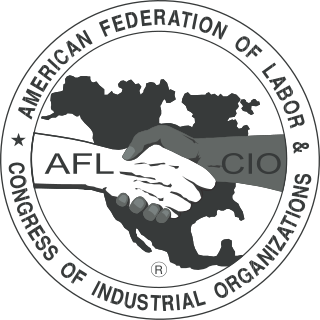
The American Federation of Labor and Congress of Industrial Organizations (AFL-CIO) is a national trade union center that is the largest federation of unions in the United States. It is made up of 60 national and international unions, together representing more than 12 million active and retired workers. The AFL-CIO engages in substantial political spending and activism, typically in support of progressive and pro-labor policies.

The International Brotherhood of Teamsters (IBT) is a labor union in the United States and Canada. Formed in 1903 by the merger of the Team Drivers International Union and the Teamsters National Union, the union now represents a diverse membership of blue and white-collar workers in both the public and private sectors, totalling about 1.3 million in 2015. The union was formerly called the International Brotherhood of Teamsters, Chauffeurs, Warehousemen and Helpers of America.

The American Federation of Labor was a national federation of labor unions in the United States that continues today as the AFL–CIO. It was founded in Columbus, Ohio, in 1886 by an alliance of craft unions eager to provide mutual support and disappointed in the Knights of Labor. Samuel Gompers was elected the full-time president at its founding convention and was re-elected every year except one until his death in 1924. He became the major spokesperson for the union movement.
The United Food and Commercial Workers International Union (UFCW) is a labor union representing approximately 1.3 million workers in the United States and Canada in industries including retail; meatpacking, food processing and manufacturing; hospitality; agriculture; cannabis; chemical trades; security; textile, and health care. UFCW is affiliated with the Canadian Labour Congress (CLC) and the AFL–CIO; it disaffiliated from the AFL–CIO in 2005 but reaffiliated in 2013. UFCW is also affiliated to UNI Global Union and the IUF.
Craft unionism refers to a model of trade unionism in which workers are organised based on the particular craft or trade in which they work. It contrasts with industrial unionism, in which all workers in the same industry are organized into the same union, regardless of differences in skill.

Daniel Joseph Tobin was an American labor leader and president of the International Brotherhood of Teamsters from 1907 to 1952. From 1917 to 1928, he was treasurer of the American Federation of Labor. He served on the federation's Executive Council beginning in 1934, and served until his resignation in 1952.
The International Typographical Union (ITU) was a North American trade union for the printing trade for newspapers and other media. It was founded on May 3, 1852, in the United States as the National Typographical Union, and changed its name to the International Typographical Union at its Albany, New York, convention in 1869 after it began organizing members in Canada. The ITU was one of the first unions to admit female members, admitting women members such as Augusta Lewis, Mary Moore and Eva Howard in 1869.

The Bakery, Confectionery, Tobacco Workers and Grain Millers International Union (BCTGM) is a labor union in the United States and Canada primarily representing workers in the food processing industry. The union was established in 1886 as the Journeyman Bakers Union. The contemporary BCTGM was formed in January 1999 as a merger of the Bakery, Confectionery and Tobacco Workers' International Union and the American Federation of Grain Millers.
The National Building Trades Council (NBTC) was an American federation of labor unions in the construction industry. It was active from 1897 to 1903.
The Structural Building Trades Alliance (SBTA) was an American federation of labor unions in the construction industry. It was founded in 1903 and existed until 1908, when it affiliated with the American Federation of Labor (AFL) and became the Building Trades Department.

The Amalgamated Lithographers of America (ALA) is a labor union formed in 1915 to conduct collective bargaining on behalf of workers in the craft of lithography. The ALA was established through the amalgamation of several small unions already existing in the lithographic industry, one of which dated back to 1886.
The Alliance for Labor Action (ALA) was an American and Canadian national trade union center which existed from July 1968 until January 1972. Its two main members were the United Auto Workers (UAW) and the International Brotherhood of Teamsters, although it had some smaller affiliates.

James P. Holland was president of the New York State Federation of Labor from 1916 to 1926.

The Congress of Industrial Organizations (CIO) was a federation of unions that organized workers in industrial unions in the United States and Canada from 1935 to 1955. Originally created in 1935 as a committee within the American Federation of Labor (AFL) by John L. Lewis, a leader of the United Mine Workers (UMW), and called the Committee for Industrial Organization. Its name was changed in 1938 when it broke away from the AFL. It focused on organizing unskilled workers, who had been ignored by most of the AFL unions.

The Building and Construction Trades Department, commonly known as North America's Building Trades Unions (NABTU), is a trade department of the American Federation of Labor and Congress of Industrial Organizations (AFL–CIO) with 14 affiliated labor unions in the building trades. It was originally founded by the American Federation of Labor in 1907.
A union raid is when a challenger or outsider union tries to take over the membership base of an existing incumbent union, typically through a union raid election in the United States and Canada.
The 1953 Milwaukee brewery strike was a strike action involving approximately 7,100 workers at six breweries in Milwaukee, Wisconsin, United States. The strike began on May 14 of that year after the Brewery Workers Union Local 9 and an employers' organization representing six Milwaukee-based brewing companies failed to agree to new labor contracts. These contracts would have increased the workers' wages and decreased their working hours, making them more comparable to the labor contracts of brewery workers elsewhere in the country. The strike ended in late July, after the Valentin Blatz Brewing Company broke with the other breweries and began negotiating with the union. The other companies soon followed suit and the strike officially ended on July 29, with union members voting to accept new contracts that addressed many of their initial concerns.

The Coors strike and boycott was a series of boycotts and strike action against the Coors Brewing Company, based in Golden, Colorado, United States. Initially local, the boycott started in the late 1960s and continued through the 1970s, coinciding with a labor strike at the company's brewery in 1977. The strike ended the following year in failure for the union, which Coors forced to dissolve. The boycott, however, lasted until the mid-1980s, when it was more or less ended.
The Distillery, Wine and Allied Workers' International Union (DWAW) was a labor union representing workers involved in making alcoholic drinks in the United States.









